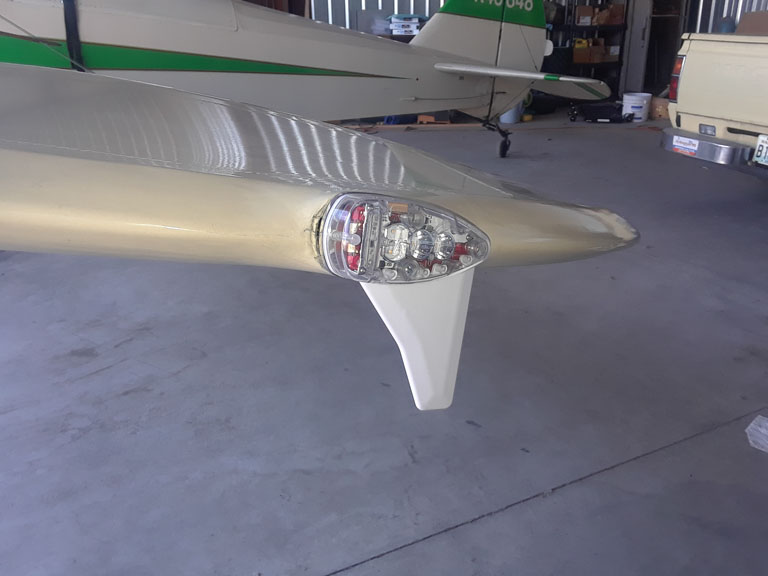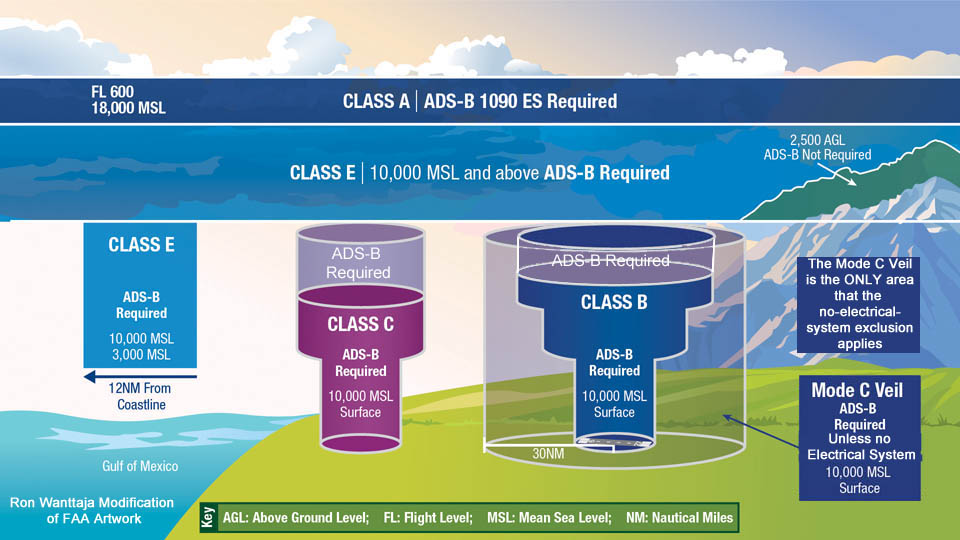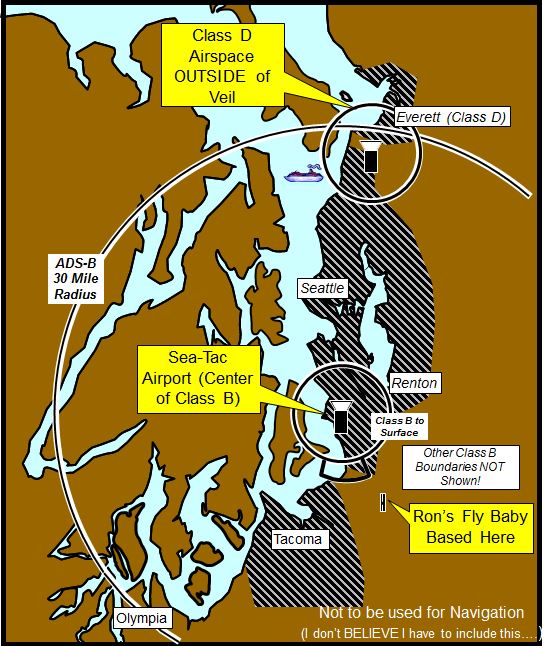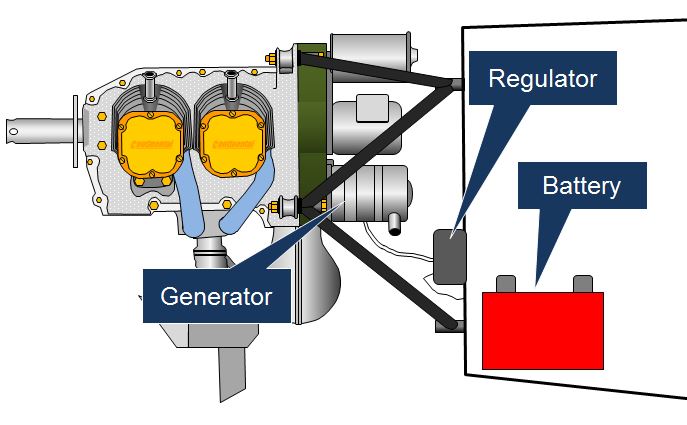You may wonder: "Why specify a
'Regulator'? What kind of system has an alternator but no
regulation?"
Some newer small engines, typically those that have come from
the ultralight world, have an alternator whose only function is
to feed electricity to the ignition system. Obviously, an
ignition coil doesn't care if it gets 12 volts or 30 volts....in
fact, it would like the 30 volts better. But the
alternator alone wouldn't be usable with sensitive avionics, so
the FAA doesn't consider it to be an electrical system.
So...What Are My Options for a Completed and Flying Fly
Baby?
Do you need a transponder and ADS-B? The answer is
obviously "yes" if you need to enter Class A, B, or C
airspace.
The only point is question is the Mode C Veil. If you
live far from any Class B airspace, the question is probably
moot. If you don't have to enter the veil, no reason to
add ADS-B.
But say you DO live close to a Class B airport. Say,
like me, you're BASED at an airport within the Mode C Veil.
This is where the engine-driven electrical system gets
tricky. If you don't have one, you can fly
within the Mode C veil without hindrance or the need for
notification.
Again, if you *are* going to need to enter Class B or C, you
need ADS-B.
The Class B Veil? Well, here it gets tricky.
Years ago, after the transponder requirement came out, a
friend of mine was faced with installing a transponder in his
own homebuilt airplane. He looked in his aircraft
logbook and notice it didn't have *anything* about an
electrical system. So...he pulled the generator out, and
when asked, claimed that the airplane had not had an
electrical system when it was built.
He kept the aircraft battery on a trickle charger, and it
would be fully charged whenever he went flying. The
battery had juice for hours of radio operation, and
ten-to-twenty starts (especially once the engine got
warm). He flew a long time without a transponder, with
none the wiser. He's passed on now, but I'm not going to
give any information about the plane. It's probably
STILL going.
Scroll up and look at the map, and note where my home
airport is. About seven miles from Sea-Tac...well within
the Veil. So I was faced with the same decision.
I have to admit that it did cross my mind to remove the
generator and claim the exemption. But...I'm a law-abiding
type, and installed a uAvionix Skybeacon last summer.
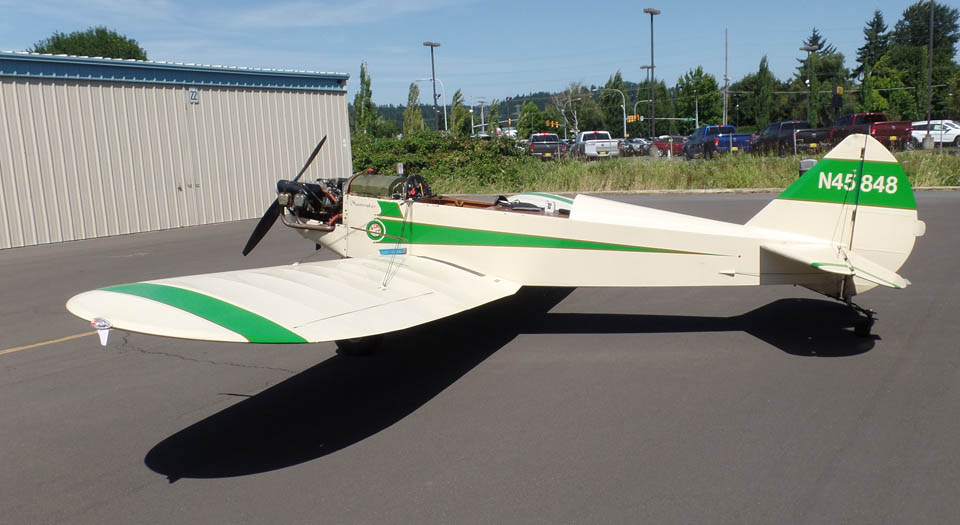
My airplane had previously-installed wingtip
lights (actually disconnected for years), and I basically had
to restore one of the circuits for use with the Skybeacon.
Back when the ADS-B rule was proposed, I was seriously
considering building a new Fly Baby rather than install ADS-B
on my current one. At that time, ADS-B was costing on
the order of ~75% of the value of my airplane. It would
have been cheaper to cut new wood, and re-use components such
as the engine, landing gear, and wheels.
But the less than $2000 price of the Skybeacon won me over.
One thing to remember is that the Fly Baby is a wooden
airplane, which is (mostly) transparent to radio
signals. I know one man with a wooden airplane that
mounted a Skybeacon on a bracket behind the passenger
compartment. Took him some level adjustment, but he got
it to work.
Options for a Fly Baby Under Construction
Your primary course should be clear: Leave the
generator off your aircraft, and use the electrical-system
exclusion. Remember, the battery will last very nicely
through a flying day, even two. Put an external jack on
the airplane that lets you plug in a battery charger between
flights. You can see mine in this picture, the dark
circle on the belly panel inboard of the gear leg. I
have a custom jack that lets me just plug in a standard
automotive charger.
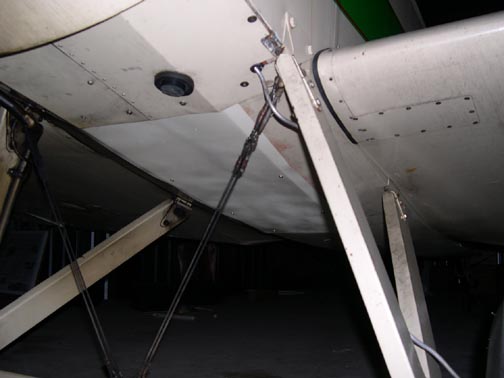
My generator went out once, and I went a
full year before removing it and getting it fixed.
Just plugged a charger into the airplane for a while after
each flight (didn't want to leave it plugged-in full time).
Put in an entire electrical system other than the
generator. Put in the regulator, too, just install a
plate on the back of the engine where the generator usually
goes. This is how you present the airplane to the
DAR. No electrical system. When he or she signs
it off, you have an aircraft "...that was not originally
certificated with an electrical system or which
has not subsequently been certified with such a system
installed..."
ADS-B not required. Unless, of course, you
actually NEED to enter Class B or C airspace. But
you're good to go, in the veil.
Playing Games with the Regulation
And...here's the kicker, and it's pretty amusing.
Once you get your airworthiness certificate, what happens if
you install the generator? Are you required to put in
a transponder and ADS-B, now, if you want to fly in the
Veil?
Note the wording of the regulation: "...or which
has not subsequently been certified with such a system
installed..." It says, "subsequently certified,"
NOT "had an electrical system added."
Get the difference? Homebuilts NEVER get "subsequent
re-certification." Adding an electrical system to a
production airplane requires a Supplemental Type
Certificate, but there's no such critter on a homebuilt.
So you could install a generator AFTER the plane has been
licensed...and the plane should still meet the letter of the
law.
However, it can be a hassle. As far as I am aware, the
FAA has *no* procedures to catch people without ADS-B,
unless the plane is communicating with ATC. Your
biggest risk is those who are too dependent on the ADS-B
*IN* readout in their airplanes, telling them where nearby
traffic is. They might get outraged if you don't show
up on their magic box, and may report you to the FAA.
In that case, you're certainly better off if there's no
generator on the airplane.
Surviving ADS-B In
"ADS-B In? But that's the data that can be
displayed in the cockpit! Why 'Surviving'?"
Yep. I doubt there'll be many Fly Babies that add the
cockpit display to show other aircraft's ADS-B Out
signals. Such displays are hard to read in an open
cockpit.
But lots of Cessna, Beech, Cirrus, and Piper drivers will be
buying them. And here's the problem: A LOT of these
guys will have their eyes glued to the ADS-B display....not
looking outside the window. If your Fly Baby doesn't have
ADS-B Out, they're not going to realize you're there!
A friend of mine put an ADS-B in display in his airplane.
Took another friend flying. All during the flight, the
aircraft owner was staring at the display...the guy in the right
seat actually had to push the yoke forward occasionally as the
plane got close to stalling!
And guess what? Guys like that are coming to uncontrolled
airports near you. If you don't have ADS-B out, they ain't
gonna know you're there.
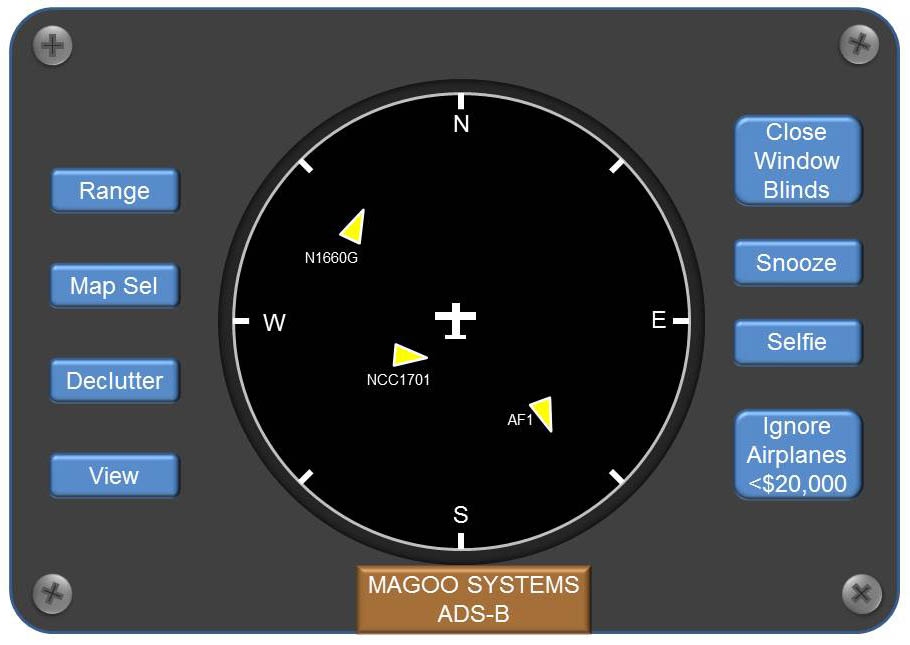
Those who have been flying NORDO are saying,
"TELL me about it." There are people out there who try
to find planes with their ears. I flew N500F without a
radio from a busy uncontrolled airport for seven
years. *I* didn't have a problem, but some folks
did. "I can't SEE you if you don't make a radio call,"
one man fumed later.
Now: I am NOT advocating that you go through all the
hassle to install ADS-B out (or a comm radio, for that
matter) just to placate all the Mr. Magoos out there.
I am NOT telling you to install an electrical system to aid
pilot-babies' addictions to the electronic teat.
What I am saying is that you're going to have to be more
careful, in the airport environs. It's a see-and-avoid
environment, and you're going to have to realize that fewer
people are going to "see" you.
You got one biiiiiig factor working in your favor:
You're flying an airplane with outstanding visibility.
USE it! Assume you're NORDO (even if you have a radio
and are making radio calls). When entering the
pattern, do what I call the "NORDO Shuffle"...wag your wings
around to see if anyone is hidden behind one, wiggle the
rudder to see if anyone is under the nose.
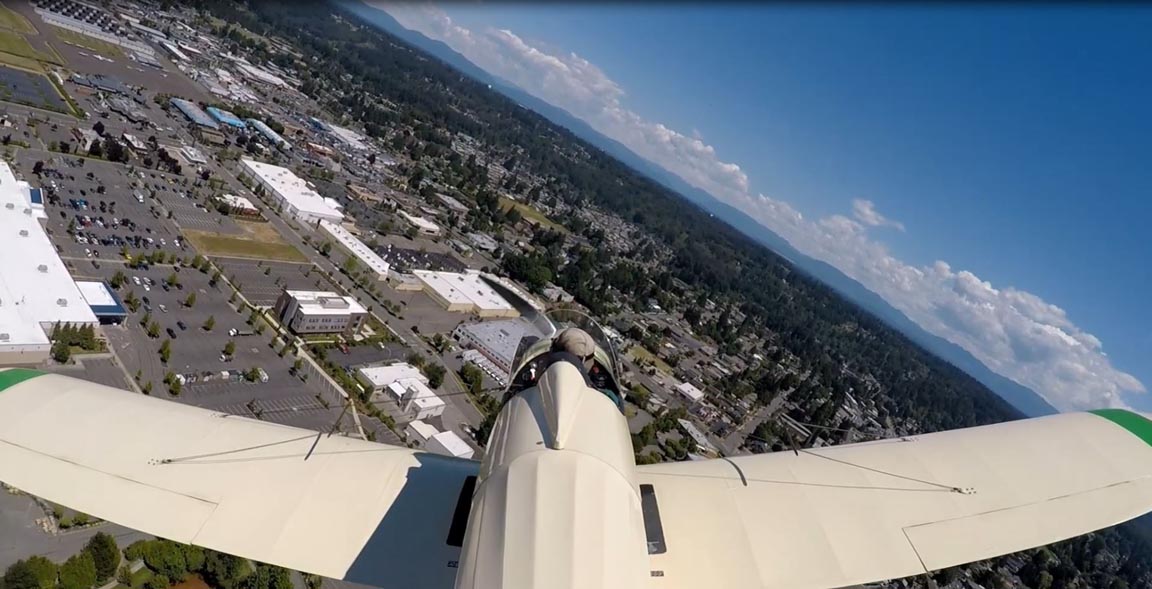
Don't forget, too, that the majority of
those %#@&^ will be flying higher-performance
airplanes. They could be coming up from behind,
head down, watching the display, sending text
messages. Check six, and often!
Remember, if you DON'T have an electrical system, and
you AREN'T actually in Class B or C airspace, you aren't
required to have ADS-B out. Don't take #### from
anyone who tells you otherwise.
Ron Wanttaja
January 2020
